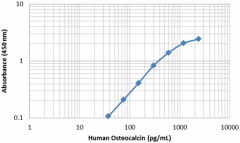- Clone
- 4B6 (See other available formats)
- Regulatory Status
- RUO
- Other Names
- Osteocalcin, uncarboxylated osteocalcin, decarboxylated osteocalcin, 3xGlu, bone gamma-carboxyglutamate protein, Bone Gla Protein, BGP, OC, OCN, unOCN
- Isotype
- Mouse IgG1, κ
- Ave. Rating
- Submit a Review
- Product Citations
- publications

-

Representative sandwich immunoassay standard curve generated using serial dilutions of Human Uncarboxylated Osteocalcin (Cat. No. 446709) ranging from 37.5 to 2400 pg/mL, 8H4 (Cat. No. 538202) as the capture antibody at 4 µg/mL, and 4B6 (Cat. No. 538304) as the detection antibody at 0.5 µg/mL.
| Cat # | Size | Price | Quantity Check Availability | Save | ||
|---|---|---|---|---|---|---|
| 538304 | 100 µg | £221 | ||||
Osteocalcin is the most abundant non-collagenous protein found in the bone. While fully-carboxylated osteocalcin has a high affinity for the extracellular matrix of the bone; decreases in pH, caused by the process of bone resorption, result in decarboxylation of this protein. This generates both partially decarboxylated (undercarboxylated) and fully decarboxylated (uncarboxylated) osteocalcin molecules which are released into the circulation due to decreased affinity for the extracellular matrix. Fully carboxylated osteocalcin requires high calcium concentrations for proper protein folding; however, under/uncarboxylated osteocalcin has no calcium requirement to maintain its structure within the blood.
Product DetailsProduct Details
- Verified Reactivity
- Human
- Antibody Type
- Monoclonal
- Host Species
- Mouse
- Immunogen
- Recombinant Human Decarboxylated (3xGLU) Osteocalcin
- Formulation
- Phosphate-buffered solution, pH 7.2, containing 0.09% sodium azide
- Preparation
- The antibody was purified by affinity chromatography and conjugated with biotin under optimal conditions.
- Concentration
- 0.5 mg/mL
- Storage & Handling
- The antibody solution should be stored undiluted between 2°C and 8°C. Do not freeze.
- Application
-
ELISA Detection - Quality tested
- Recommended Usage
-
Each lot of this antibody is quality control tested by ELISA assay. For ELISA Detection applications, a concentration range of 1.0 - 4.0 µg/mL is recommended. To obtain a linear standard curve, serial dilutions of Human Uncarboxylated Osteocalcin recombinant protein (Cat. No. 446709) ranging from 37.5 to 2400 pg/mL is recommended for each ELISA plate. It is recommended that the reagent be titrated for optimal performance for each application.
- Application Notes
-
The biotinylated 4B6 antibody (Cat. No. 538304) is useful as the detection antibody in a sandwich ELISA assay, when used in conjunction with the pure 8H4 antibody (Cat. No. 538202) as the capture antibody and Human Uncarboxylated Osteocalcin synthetic peptide as the ELISA Std. (Cat. No. 446709).
- RRID
-
AB_2888711 (BioLegend Cat. No. 538304)
Antigen Details
- Structure
- Monomer
- Distribution
-
It is produced by osteoblasts as a 49 amino acid protein, which contains 3 glutamine acid residues (Glu 17, 21, and 24) that are gamma carboxylated in a vitamin K dependent manner.
- Function
- Under/uncarboxylated forms act as hormones promoting β-cell proliferation, adiponectin secretion, insulin sensitivity, glucose tolerance, and testosterone biosynthesis. In patients with diabetes, reduced serum levels of osteocalcin are negatively correlated with obesity and insulin resistance. Furthermore, supporting studies in mice have suggested potential therapeutic applications for osteocalcin in both obesity and insulin resistance.
- Interaction
- GPRC6A, insulin, pancreatic β-cells, Ley-dig cells, adiponectin
- Ligand/Receptor
- Under/uncarboxylated forms can bind the receptor GPCR6a, calcium, and metal-binding.
- Cell Type
- Osteoblasts
- Molecular Family
- Hormones
- Antigen References
-
- Booth SL, et al. 2013. Nat Rev Endocrinol. 9:43.
- Diaz-Franco MC, et al. 2019. Mol Med Rep. 19:15-22.
- Karsenty G, et al. 2014. Mol Cell Endocrinol. 382:521.
- Zoch ML, et al. 2016. Bone. 82:42-9.
- Gene ID
- 632 View all products for this Gene ID
- UniProt
- View information about Uncarboxylated Osteocalcin on UniProt.org
Related FAQs
- How many biotin molecules are per antibody structure?
- We don't routinely measure the number of biotins with our antibody products but the number of biotin molecules range from 3-6 molecules per antibody.
Other Formats
View All Uncarboxylated Osteocalcin Reagents Request Custom Conjugation| Description | Clone | Applications |
|---|---|---|
| Biotin anti-human Uncarboxylated Osteocalcin | 4B6 | ELISA Detection |
Compare Data Across All Formats
This data display is provided for general comparisons between formats.
Your actual data may vary due to variations in samples, target cells, instruments and their settings, staining conditions, and other factors.
If you need assistance with selecting the best format contact our expert technical support team.
-
Biotin anti-human Uncarboxylated Osteocalcin

Representative sandwich immunoassay standard curve generated...

 Login / Register
Login / Register 











Follow Us